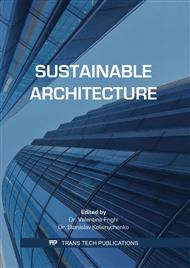[1]
C. James, Recovering landscape: Essays in Contemporary Landscape Architecture, M. Princeton Architectural Press, New York, (1999).
DOI: 10.1017/s1359135500002293
Google Scholar
[2]
J. Zhai, Coordinative Symbiosis: From Grey Municipal Infrastructure and Green Ecological Infrastructure to Integrate Landscape Infrastructure, Planners. J. 28(9) (2012) 71-74.
Google Scholar
[3]
R. Yang, Y. F. Yang, Landscape Integration of Ningbo Airport Elevated Expressway - Based on the Concept of Landscape Infrastructure, J. Chin. Landsc. Archit. 5 (2014) 69-73.
Google Scholar
[4]
L. Li, Research on the Design and Practice of Modern Urban Landscape Infrastructure, D. Beijing Forestry University, (2011).
Google Scholar
[5]
R. Yang, Y. Y. Cui, Landscape as Infrastructure: Ecological Integration of E-waste Landfills at Nanjing's Peri-Urban Areas, J. Chin. Landsc. Archit. 28(7) (2012) 101-106.
Google Scholar
[6]
B. Pierre, Landscape as Infrastructure, J. Landsc. J. 28(1) (2009) 79-95.
Google Scholar
[7]
R. Yang, Landscape Urbanism: Eco-approaches as Seeds" in China, s Urban Transformation, Chin. Landsc. Archit. J. 9 (2011) 47-51.
Google Scholar
[8]
Y. Y. Hong, Landscape Infrastructure: in plain view, J. Landsc. Archit. 3 (2009) 44-53.
Google Scholar
[9]
L. Wang, L. Wang, Development of American Eco-Planning (One) – History and Enlightenment, J. Guangdong Landsc. Archit, 31(5) (2005) 7-10.
Google Scholar
[10]
A. Thorbjörn, Landscape Urbanism versus Landscape Design The potential of design must not be neglected, J. Topos (2010).
Google Scholar
[11]
P. Yang, Landscape as Flows: An Ecological Design Approach to Large-Scale Urban Landscape, J. World Archit. 1 (2010) 80-84.
Google Scholar
[12]
J. Zhai, A Preliminary Study on Landscape Infrastructural Park with the Urban Stormwater Park as an Example, J. Urban Plan. Int. 5 (2015).
Google Scholar
[13]
M. Ülo, J. Jagomägi, K. Mart, Network of compensative areas as an ecological infrastructure of territories, J. Münstersche Geographische Arbeiten. 29 (1988) 35-38.
Google Scholar
[14]
A. J. Van Selm, Ecological infrastructure: a conceptual framework for designing habitat networks, Connectivity in landscape ecology, Proceedings of the 2nd international seminar of the International Association for Landscape Ecology, 1988, 63-66.
Google Scholar
[15]
K. J. Yu, D. H. Li, Ten Landscape Strategy of Urban Ecological Infrastructure, J. Planners. 6 (2001) 9-13.
Google Scholar
[16]
G. Stephen, M. Simon, Splintering Urbanism, M. Routledge, USA, (2001).
Google Scholar
[17]
J. Jane, The Death and Life of Great American Cities, M. Vintage Books, New York, (1992).
Google Scholar



